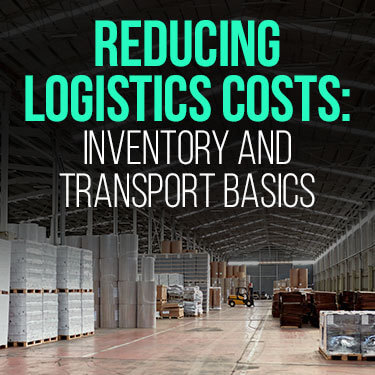
 Copy URL to Clipboard
Copy URL to Clipboard
Reducing logistics costs as a whole means being aware of your operations at every level. Your logistics can refer to a number of different operations from customer shipping services to making sure your office has enough lightbulbs. If you are just starting to build momentum with your business, analyzing your logistics budget is crucial. Good practices from the start can save you later.
The Council of Supply Chain Management Professionals (CSCMP) has highlighted the rising costs of inventory management and transportation. Proper planning is needed to reduce spending and streamline logistics operations. Companies need to plan ways to store and distribute products for clients while keeping a growth mindset.
Get a better understanding of inventory and transportation logistics to help you reduce logistics costs and get your business growing in the right direction.
Table of Contents
Before you start drafting up any plan to reduce your logistics expenses, it’s important to understand how they’ve come to be such a large part of company budgets. Logistics in general is a very broad term. Any actions taken by your company to move products through the supply chain, from procurement to final fulfillment, may be considered part of logistics.
Logistics spending often includes:
Just how much do companies spend on these practices? In terms of profit, on average, companies are spending about 11% of their total profits to fund logistics spending.
A breakdown of the largest expenses is below.
| Activity | Percentage of Logistics Budget |
| Transportation | 50.3% |
| Inventory Carrying | 21.8% |
| Labor | 9.5% |
| Customer Service) | 7.8% |
| Other | 10.4% |
According to a study in 2020, the majority of that 11% goes to transportation needs - about 50.3% on average. It’s a trend that isn’t likely to slow down anytime soon and, in fact, has already become more expensive in the years following the study.
Modern supply chain logistics need to contend with:
With so many things driving up the cost of logistics, is there truly a way to reduce costs? This would depend on perspective. Can you go back to pre-pandemic costs? Honestly, no - current world events have made such things impossible.
Can you implement business practices that will keep you from spending money you could otherwise save? Possibly - which in the current logistics business, is about as much reassurance as you are going to get.
The idea is to approach logistics with a growth mindset and be ready to change things up as circumstances allow. More than ever before, the focus should be on optimizing current practices to make them more streamlined. In the long term, this will prove more effective than indiscriminate cost-cutting.
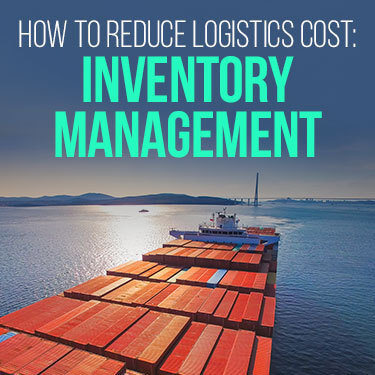
Let’s start with the second most expensive part of logistics expenses - inventory carrying and management. Any business venture offering products is eventually going to need inventory space (unless you’re a drop shipper) and management tools to keep it organized.
Warehouse space is becoming more limited and what does become available is often at a premium price. If you are looking to expand your business, you want to find a space that can meet your current needs while giving you some room to grow.
For established businesses looking for ways to reduce current inventory costs, it may be necessary to analyze how you organize, store, and fulfill your current products.
Here are some areas of inventory management that should be examined closely.
You may have signed a lease or even purchased land of your own to build a warehouse. Either way, this is a long-term decision. Choosing the cheapest of everything isn’t a solution either.
Consider some of these questions.
If you sign on with or build a warehouse that doesn’t meet your current and projected needs, you could be spending more money in the long run. This is especially true if your projected plans don’t align with scheduled shipments.
Finding space last minute to store shipping containers because your original warehouse plans fell through is going to cost you money and time you may not get back.
Too small of a space will have you breaking a contract and paying penalties as you try to find a larger space. A lack of loading docks could affect your supply chain because certain suppliers may refuse delivery.
Finalize warehouse and distribution plans before you make large import or manufacturing orders.
Then there are the three things that matter most in a realty deal: location, location, location. A bad location, even at the right price, could raise your shipping and operating costs well beyond whatever savings you had imagined for yourself.
Consider some of these scenarios:
For each of the scenarios above, there were different possible solutions that had to do with warehousing, distribution, and shipping. Will each possible solution presented work every time? Not likely, because circumstances are always changing.
You might pay more for a warehouse near a port, but it will save you on shipping by minimizing unnecessary product movement. An overland truck route may be faster, but cost more than rail and final mile fulfillment combined. At any point, the opposite may also be true.
The key takeaway here is to be flexible and ready to adapt. The better your view and understanding of your company’s operations as a whole, the more likely you are to make needed changes in a prompt and decisive way.

As soon as you have inventory in a warehouse, carrying costs start to build up. A company’s carrying costs are any and all expenses needed to store and manage unsold goods.
Some level of carrying costs is inevitable. With the state of the modern supply chain, having some extra inventory on hand is considered necessary by many. That being said, if you are focused on reducing logistics costs, this may be one of the simpler ways of doing so.
Proper demand planning can help you navigate high and low sales periods in a way that allows you to cut costs. This is especially true for merchandise that is seasonal in nature or heavily affected by holidays. For instance, if you run a clothing store, you don’t want to put in bulk orders for swimsuits just as winter is starting, or for jackets as the spring season hits.
Merchandise that can’t be sold in a reasonable length of time is taking up space and creating additional labor costs within the warehouse. In an ideal world, you should be turning over inventory within one to two months of it entering a warehouse. Anything past that could be considered obsolete inventory.
Other ways to reduce the impact of carrying costs include:
Many people are tempted to increase their safety stock and hold on to certain inventory items due to current supply chain issues. Yes, there have been increased shortages, but you must consider the long-term cost here.
Remember, storage and warehousing are two different things. A fulfillment warehouse does not want to hold onto merchandise that isn’t getting moved.
Current warehouse pricing means that you will end up paying more to store your old inventory than what you could potentially make in future sales profits. In other words, cut your losses out early. Holding a clearance sale or even donating obsolete items will still save you money in the grand scheme of things.
The main takeaway is that you must consider all impacts of a decision. Your warehousing decisions, safety stock amounts, and more depend on actual and perceived needs and wants on your side and your client’s side.
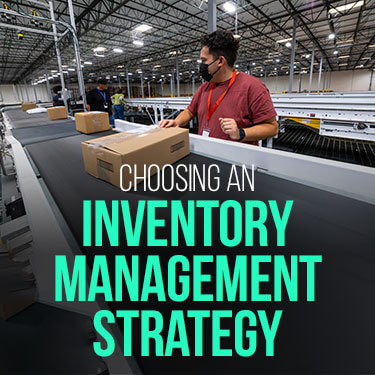
Your inventory management procedures are another logistics process to explore for cost-effective practices. There are three common inventory management strategies.
These logistics supply management procedures determine how goods leave storage and go to customers. There are benefits to each of these depending on your business model.
For instance, LIFO doesn’t make much sense to businesses initially. It seems counterproductive to some to hang onto old things. For an industry that deals in perishables, that would be absolutely right.
However, let's say that you are running a lumber yard. The price of lumber has climbed and each new load you receive is valued higher than the last. Selling off the higher-value wood first may save money when calculating your inventory taxes later.
Not every state charges an inventory tax, but for those that do, LIFO is a definite option. It works for someone running a lumber yard, or similar non-perishable commodities because wood really isn’t likely to go bad when kept in the right environment. Inventory tax is based on initial purchase value rather than retail value. If the price of lumber keeps climbing, selling off the most expensive wood you paid for first brings down the inventory value you would be taxed on.
For more information on inventory tax, see our article, “What is an Inventory Tax?”
In terms of logistics expenses, cost control has more to do with spending wisely than just aiming to spend less.
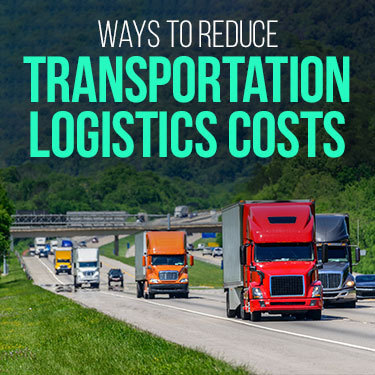
Now it’s time to discuss the biggest expense in logistics - transportation and shipping. Much like warehouse space, the average cost of shipping has more than doubled across the industry. From marine containers to LTL to air cargo, things just cost more.
As diesel prices continue to set new record highs each week, shipping prices are likely to keep rising. The price hikes have forced many to raise product prices in an effort to keep up with administrative costs.
Within a six-month period between 2021 and 2022, the rise in fuel costs has been astronomical.
| Month/Year | Average Cost per Gallon |
| November 2021 | $3.73 |
| December 2021 | $3.64 |
| January 2022 | $3.72 |
| February 2022 | $4.03 |
| March 2022 | $5.11 |
| April 2022 | $5.12 |
In certain parts of the country, these figures are much higher, even up to $6 per gallon of diesel.
Changing certain shipping practices to better manage freight costs will be more effective than jumping from carrier to carrier always looking for the cheapest price. When prices are high across the board, look for quality and precision in shipping services.
There was a time when small, frequent shipments were worthwhile, both domestically and internationally. It meant that goods could get to places faster and made it possible for smaller businesses to offer fast delivery options for customers.
Those smaller, faster shipments were ideal for companies that maintain fairly small inventories (which also reduces logistics costs). The rise in pricing has now removed some of that advantage.
Supply chain costs can be kept under better control with the use of alternative strategies.
Other, smaller changes can be made according to individual industry needs. If you transport and manage bulk liquids, switching from rounded to squared storage units could save you on space needs. Perhaps you have items that take a longer time to load. Adjusting driver habits so that trucks aren’t left idling for extended times may impact fuel costs.
Sometimes savings will come down to small habits and practices often overlooked. These changes, multiplied across various parts of your business, can have extensive impacts on reducing logistics costs.
Logistics doesn't just involve shipping out to customers; you also have to handle inventory coming in. Find out more about optimizing your inbound logistics.
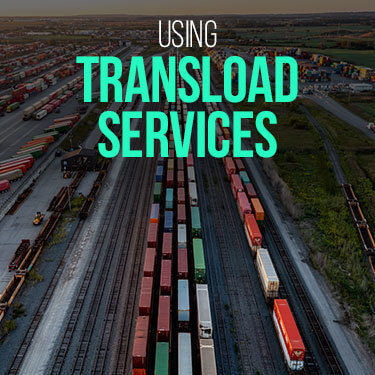
Keeping goods moving is necessary to avoid costly delays. When you have a contractual agreement to provide a certain number of goods within a set time frame, any breach can result in penalties.
Shipping containers of inventory stuck at the port? Chances are you aren’t going to make that next scheduled delivery of Egyptian cotton bed sheets to the linen store. Not to mention the port itself is likely to charge you demurrage fees for failing to move the container within the allotted free time.
Transload services are used to unload and transfer freight from one form of transport to another. This service keeps goods moving along the supply chain and helps you avoid delays and the fees that come with them.
Whether it needs to move from a shipping container to a dry van, or a dry van into a railway car - transload is there to keep it moving. It can be especially beneficial for bulk liquid. A transload facility has specially designed pumps that can move bulk liquids from iso tanks and flexitanks to tanker trucks.
Major bulk liquids include:
Transload Services have the added benefit of being easily combined with other cost-saving measures such as:
With intermodal services, you can actually use transload to get goods on the railways or airplanes. As convenient as these can be, truck service remains the most flexible and accessible delivery means.
Shipping by rail may seem cheaper in the short term, but you will be paying for loading and unloading services to get goods on and off for that final mile. The constant fluctuation of pricing means full truckload or LTL shipments may still be the better option.
The truth is that possibilities are endless. At any given point, rail, truck, or air cargo could be the least expensive option. There are simply too many factors in play to proclaim that one will always be the best option for reducing logistics costs. Instead, the best advice we can give is to state that the best option is to be flexible.
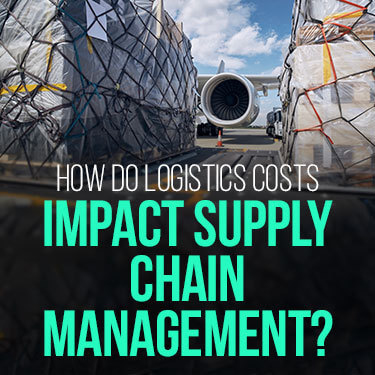
Logistics costs and supply chain management actually go hand in hand. Managing a supply chain effectively requires logistics teams to plan out costs and account for weaknesses when they appear.
Poor planning on the part of the logistics team could result in greater disruptions to a company’s supply chain. Delays due to insufficient inventory, poor warehouse management, and inefficient shipping decisions are going to cost you in terms of loyal clients. Without sufficient clients, there is no business or business logistics.
Using a combination of the strategies described so far will aid in managing the more difficult aspects of your supply chain.
You’ve gotten your warehouse optimized for storage and fulfillment and your transport fees are more streamlined than ever before. However, you are still getting caught by late fees because of manufacturer errors.
In this case, the lead times of your suppliers might be the problem. Lead times refer to the length of time it takes for a product to go from start to finish in manufacture.
These times will vary according to industry. The lead time on an order of 20 bread loaves from the bakery might be just 2 hours. Lead time on a fully loaded pickup truck might be two months.
While it’s understood that some delays will happen, frequent or constantly changing lead times are disruptive to business and bad for logistics budget planning.
Carriers and Third-Party Logistics (3PL) services will often be able to negotiate better rates with you when you provide them with steady and constant service. To achieve this, you need a supplier who will be accurate and consistent.
All else being equal, a supplier than can guarantee a set number of products once a month will prove more valuable than one who can’t give you a firm number. Having multiple suppliers who can ship into different locations may also provide you with enough coverage so that you always have supplies on hand.
Going to a 3PL or carrier and telling them you will have X number of pallets for cross docking services every 3 to 45 days is not going to help you get better rates or service.
Although cliche, the old saying of never putting all your eggs in one basket is as true today as ever before. Diversification is going to save you in the long run because it provides options.
When all is said and done, reducing logistics costs has more to do with optimizing current practices and being smart about where and how you spend your money.
Don’t sacrifice quality and precision for the cheapest bidder. At R+L Global Logistics, we want to help you grow your business by keeping your customers happy and loyal.
Our leaders have decades of experience in logistics management and can work with you to find practical solutions in warehousing, distribution, and fulfillment services that keep your business going.
Let R+L Global be your one-stop shop for
Get in touch with our logistics specialists today at (866) 989 - 3082 or request an online services quote today
